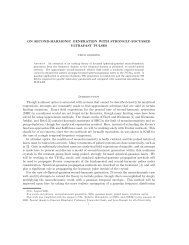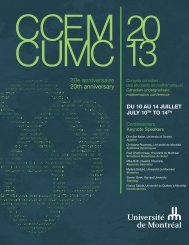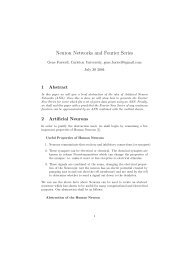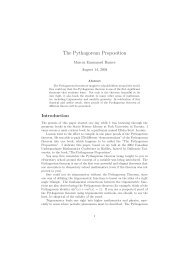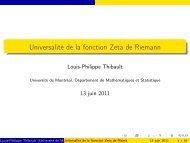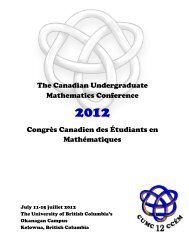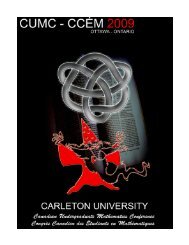booklet - CUMC - Canadian Mathematical Society
booklet - CUMC - Canadian Mathematical Society
booklet - CUMC - Canadian Mathematical Society
You also want an ePaper? Increase the reach of your titles
YUMPU automatically turns print PDFs into web optimized ePapers that Google loves.
QUAND BIOLOGIE ET MATHÉMATIQUES SE RENCONTRENT: LES RÉSEAUX DE NEU-RONES ARTIFICIELSJÉRÉMIE VILLENEUVEL’apprentissage est sans contredit un processus complexe. Beaucoup d’efforts sontdéployés afin de mieux le comprendre et de le reproduire informatiquement. Ainsi,une voie explorée consiste à produire des modèles mathématiques basés sur les propriétésdes neurones biologiques. Cette conférence propose donc une revue généraledes réseaux de neurones artificiels en abordant des questions comme: Comment fonctionnentils?Comment apprennent-ils? Peuvent-ils apprendre quelque chose d’utile?ABOUT SELF-ORGANIZED THERMOREGULATION OF HONEYBEE CLUSTERSJEREMY CHIUA presentation going in depth about the derivation and discretization to Watmoughand Camazine’s paper Self-Organized Thermoregulation of Honeybee Clusters. Thepaper describes a model used to examine the thermoregulation of a honeybee swarmbased on the bees’ movements and metabolism. We discuss how we discretized andsolved the system. We further describe our improvements to the model. The aim ofthis presentation is to show what math modelling is to students with little experience inapplied math. As such, we will also lightly touch upon topics including finite differenceschemes, non-dimensionalization, and bug testing.GIS MODEL FOR BEAR MOVEMENT AND HUMAN INTERACTIONSJESSA MARLEYA geographic information systems model was made using Matlab to map the movementof black bears through a landscape. It was made in order to determine how longit takes for a black bear to become a problem bear, which is a bear that acts on theirlearned behaviour to such an extent that they produce a threat to human safety andproperty when seeking out human food and/or garbage. There are three layers of matrices,land, food and humans. Humans either attract, repel or are neutral and food isgiven a value between 1 and 5, 5 being plentiful. The bear is also given a memory andmoves accordingly. The bear examines all possible movements around it, and using aprobability formula, the bear determines which spot will be best. The program is runfor 400 time steps, each half a day, to see how long it takes each bear to become a problem.This theoretical research can also be used to determine where education is mosteffective and shows how the distribution of people effects bears.31



